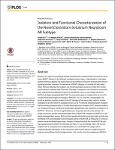Isolation and Functional Characterization of the Novel Clostridium botulinum Neurotoxin A8 Subtype
Kull, Skadi
Schulz, Melanie
Strotmeier, Jasmin Weisemann née
Kirchner, Sebastian
Schreiber, Tanja
Bollenbach, Alexander
Dabrowski, Piotr Wojtek
Nitsche, Andreas
Kalb, Suzanne R.
Dorner, Martin
Barr, John R.
Rummel, Andreas
Dorner, Brigitte
Botulism is a severe neurological disease caused by the complex family of botulinum neurotoxins (BoNT). Based on the different serotypes known today, a classification of serotype variants termed subtypes has been proposed according to sequence diversity and immunological properties. However, the relevance of BoNT subtypes is currently not well understood. Here we describe the isolation of a novel Clostridium botulinum strain from a food-borne botulism outbreak near Chemnitz, Germany. Comparison of its botulinum neurotoxin gene sequence with published sequences identified it to be a novel subtype within the BoNT/A serotype designated BoNT/A8. The neurotoxin gene is located within an ha-orfX+ cluster and showed highest homology to BoNT/A1, A2, A5, and A6. Unexpectedly, we found an arginine insertion located in the HC domain of the heavy chain, which is unique compared to all other BoNT/A subtypes known so far. Functional characterization revealed that the binding characteristics to its main neuronal protein receptor SV2C seemed unaffected, whereas binding to membrane-incorporated gangliosides was reduced in comparison to BoNT/A1. Moreover, we found significantly lower enzymatic activity of the natural, full-length neurotoxin and the recombinant light chain of BoNT/A8 compared to BoNT/A1 in different endopeptidase assays. Both reduced ganglioside binding and enzymatic activity may contribute to the considerably lower biological activity of BoNT/A8 as measured in a mouse phrenic nerve hemidiaphragm assay. Despite its reduced activity the novel BoNT/A8 subtype caused severe botulism in a 63-year-old male. To our knowledge, this is the first description and a comprehensive characterization of a novel BoNT/A subtype which combines genetic information on the neurotoxin gene cluster with an in-depth functional analysis using different technical approaches. Our results show that subtyping of BoNT is highly relevant and that understanding of the detailed toxin function might pave the way for the development of novel therapeutics and tailor-made antitoxins.
Dateien zu dieser Publikation
Keine Lizenzangabe
Verwandte Publikationen
Anzeige der Publikationen mit ähnlichem Titel, Autor, Urheber und Thema.
-
2016-05-17ZeitschriftenartikelBotulinum Neurotoxin Serotype A Recognizes Its Protein Receptor SV2 by a Different Mechanism than Botulinum Neurotoxin B Synaptotagmin Weisemann, Jasmin; Stern, Daniel; Mahrhold, Stefan; Dorner, Brigitte; Rummel, AndreasBotulinum neurotoxins (BoNTs) exhibit extraordinary potency due to their exquisite neurospecificity, which is achieved by dual binding to complex polysialo-gangliosides and synaptic vesicle proteins. The luminal domain 4 ...
-
2022-02-02ZeitschriftenartikelConstruction and validation of safe Clostridium botulinum Group II surrogate strain producing inactive botulinum neurotoxin type E toxoid Nowakowska, Maria B.; Selby, Katja; Przykopanski, Adina; Krüger, Maren; Krez, Nadja; Dorner, Brigitte G.; Dorner, Martin B.; Jin, Rongsheng; Minton, Nigel P.; Rummel, Andreas; Lindström, MiiaBotulinum neurotoxins (BoNTs), produced by the spore-forming bacterium Clostridium botulinum, cause botulism, a rare but fatal illness affecting humans and animals. Despite causing a life-threatening disease, BoNT is a ...
-
2007-05-25ZeitschriftenartikelFepA- and TonB-dependent bacteriophage H8: receptor binding and genomic sequence. Rabsch, Wolfgang; Ma, Li; Wiley, Graham; Najar, Fares Z.; Kaserer, Wallace; Schuerch, Daniel W.; Klebba, Joseph E.; Roe, Bruce A.; Gomez, Jenny A. Laverde; Schallmey, Marcus; Newton, Salete M. C.; Klebba, Phillip E.H8 is derived from a collection of Salmonella enterica serotype Enteritidis bacteriophage. Its morphology and genomic structure closely resemble those of bacteriophage T5 in the family Siphoviridae. H8 infected S. enterica ...

